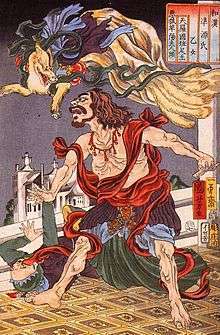Fox spirit
The fox spirit (狐狸精) or nine-tailed fox (九尾狐), having been originated from Chinese mythology, is a common motif in the mythology of East Asian countries.
In East Asian folklore, foxes are depicted as a familiar spirit possessed of magic powers. These foxes are depicted as mischievous, usually tricking other people, with the ability to disguise as an attractive female human:
"The fox spirit is an especially prolific shapeshifter, known variously as the húli jīng (fox spirit) in China, the kitsune (fox) in Japan, and the kumiho (nine-tailed fox) in Korea. Although the specifics of the tales vary, these fox spirits can usually shapeshift, often taking the form of beautiful young women who attempt to seduce men, whether for mere mischief or to consume their bodies or spirits."[1]
Development
Nine-tailed foxes appear in Chinese folklore, literature, and mythology, in which, depending on the tale can be a good or a bad omen.[2] The motif of nine-tailed foxes from Chinese culture were eventually transmitted and introduced to Korean and Japanese culture.[3]
During the Han dynasty, the development of ideas about interspecies transformation had taken place in Chinese culture.[4] The idea that non-human creatures with advancing age could assume human form is presented in works such as the Lunheng by Wang Chong (27-91).[4] As these traditions developed, the fox's capacity for transformation was shaped.[4]
Descriptions
The nine-tailed fox occurs in the Shanhaijing (Classic of Mountains and Seas), compiled from the Warring States period to the Western Han period (circa 4th to circa 1st century BC).[5] The work states:
"The Land of Green-Hills lies north of Tianwu. The foxes there have four legs and nine tails. According to another version, it is located north of Sunrise Valley."[5]
In chapter 14 of the Shanhaijing, Guo Pu had commented that the nine-tailed fox was an auspicious omen that appeared during times of peace.[5] However, in chapter 1, another aspect of the nine-tailed fox is described:
"Three hundred li farther east is Green-Hills Mountain, where much jade can be found on its south slope and green cinnabar on its north. There is a beast here whose form resembles a fox with nine tails. It makes a sound like a baby and is a man-eater. Whoever eats it will be protected against insect-poison (gu)."[5]

In one ancient myth, Yu the Great encountered a white nine-tailed fox, which he interpreted as an auspicious sign that he would marry Nüjiao.[5] In Han iconography, the nine-tailed fox is sometimes depicted at Mount Kunlun and along with Xi Wangmu in her role as the goddess of immortality.[5] According to the first-century Baihutong (Debates in the White Tiger Hall), the fox's nine tails symbolize abundant progeny.[5]
Describing the transformation and other features of the fox, Guo Pu (276-324) made the following comment:
"When a fox is fifty years old, it can transform itself into a woman; when a hundred years old, it becomes a beautiful female, or a spirit medium, or an adult male who has sexual intercourse with women. Such beings are able to know things at more than a thousand miles' distance; they can poison men by sorcery, or possess and bewilder them, so that they lose their memory and knowledge; and when a fox is thousand years old, it ascends to heaven and becomes a celestial fox."[6]
The Youyang Zazu made a connection between nine-tailed foxes and the divine:
"Among the arts of the Way, there is a specific doctrine of the celestial fox. [The doctrine] says that the celestial fox has nine tails and a golden color. It serves in the Palace of the Sun and Moon and has its own fu (talisman) and a jiao ritual. It can transcend yin and yang."[7]
Traditions
Popular fox worship during the Tang dynasty has been mentioned in a text entitled Hu Shen (Fox gods):
"Since the beginning of the Tang, many commoners have worshiped fox spirits. They make offerings in their bedchambers to beg for their favor. The foxes share people’s food and drink. They do not serve a single master. At the time there was a figure of speech saying, 'Where there is no fox demon, no village can be established.'"[8]
References
- ↑ Weinstock, Jeffrey Andrew (2014). The Ashgate Encyclopedia of Literary and Cinematic Monsters. p. 510
- ↑ Kang 2006, 15–21.
- ↑ Wallen, Martin (2006). Fox. London: Reaktion Books. pp. 69–70. ISBN 9781861892973.
- 1 2 3 Huntington 2003, 9.
- 1 2 3 4 5 6 7 Strassberg 2002, 88-89 & 184.
- ↑ Kang 2006, 17.
- ↑ Kang 2006, 23.
- ↑ Huntington 2003, 14.
Literature
- Huntington, Rania (2003). Alien kind: Foxes and late imperial Chinese narrative. Cambridge: Harvard University Press. ISBN 9780674010949.
- Kang, Xiaofei (2006). The cult of the fox: Power, gender, and popular religion in late imperial and modern China. New York: Columbia University Press. ISBN 9780231133388.
- Strassberg, Richard E. (2002). A Chinese Bestiary: Strange Creatures from the Guideways Through Mountains and Seas. Berkeley: University of California press. ISBN 0-520-21844-2.